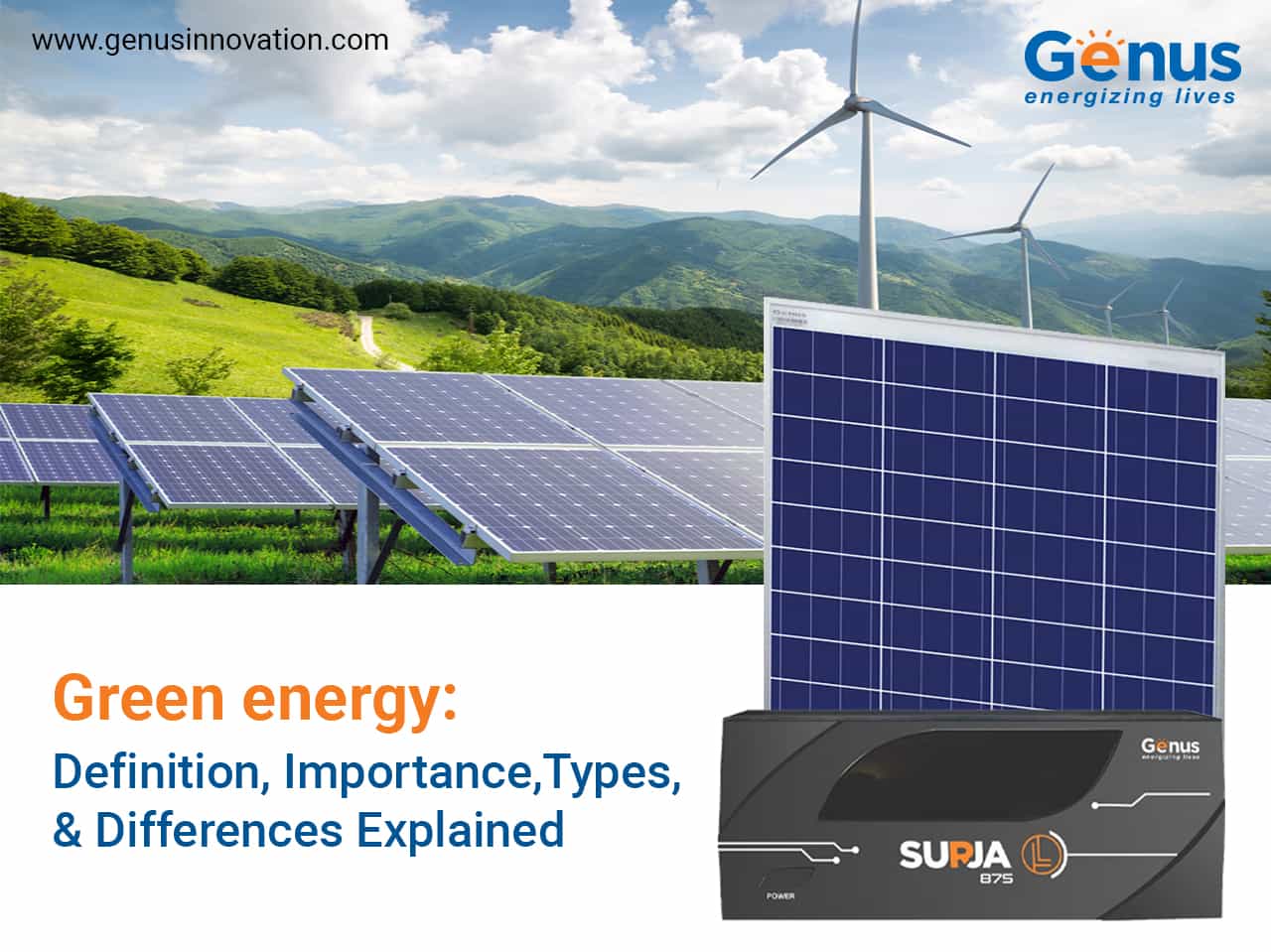What is Green Energy?
Green energy, also known as renewable or clean energy, refers to power generated from natural resources such as sunlight, wind, and water. These sources are abundant and sustainable, meaning they don’t deplete over time and have minimal environmental impact. Unlike fossil fuels, green energy does not release harmful greenhouse gases, making it a cleaner alternative for powering homes and businesses.
At Genus Innovation, we believe in harnessing the power of nature to create a more sustainable future. Our range of solar products helps you transition to green energy, offering efficient and eco-friendly solutions that protect the environment while reducing your electricity bills.

How Does Green Energy Help the Environment?
Green energy plays a vital role in protecting our planet. Here’s how:
- It reduces reliance on fossil fuels, which are major contributors to air pollution and climate change. Instead, it uses renewable sources like wind, solar, and water—clean and naturally replenished.
- Even when considering the entire life cycle of green energy technologies, their carbon footprint is significantly lower than traditional energy sources. This helps reduce overall emissions and protects ecosystems.
- Green energy systems can be more cost-effective in the long run, especially when sourced locally. They are less vulnerable to global market fluctuations, geopolitical tensions, and supply chain issues. For instance, a Genus inverter battery ensures reliable power during outages, providing stability for homes and businesses.
- The renewable energy sector has created millions of jobs worldwide, contributing to economic growth and job creation. In 2018 alone, over 11 million jobs were generated globally in the renewable energy industry (source: TWI Global).
- Renewable energy infrastructure is often decentralized, increasing resilience against disruptions caused by extreme weather or other climate-related events.
- Finally, green energy is accessible and affordable, helping communities around the world meet their energy needs without harming the environment.
What Are the Different Types of Green Energy?
There are several types of green energy, each derived from different natural sources. Let’s take a closer look at the most common ones:
1. Solar Energy
Solar energy comes directly from the sun. The sun emits vast amounts of energy through nuclear fusion, and some of this reaches Earth as sunlight. Solar panels capture this energy and convert it into electricity using photovoltaic cells. When sunlight hits these cells, it generates an electric current, which is then converted into usable alternating current via an inverter. A Genus home solar system is an excellent choice for those looking to reduce energy consumption and embrace a greener lifestyle.
2. Wind Energy
Wind energy is generated by wind turbines that convert the kinetic energy of wind into electricity. Wind is caused by the uneven heating of the Earth's surface by the sun, and as wind moves across land or water, it can be harnessed for power. Wind energy is clean, produces no emissions, and is becoming increasingly efficient and widespread. A Genus solar tubular battery can provide extended power backup, ensuring you stay powered even during outages.
3. Hydroelectric Energy
Hydroelectric energy is produced by capturing the energy of flowing water. Dams and reservoirs are used to store water, which is then released to spin turbines and generate electricity. This method is highly efficient and widely used around the world. It doesn't produce pollution, making it one of the most environmentally friendly energy sources available.
4. Biogas
Biogas is a renewable energy source made from organic waste such as food scraps, manure, and sewage. Through a process called anaerobic digestion, these materials break down in the absence of oxygen, producing methane and other gases. This gas can be used for cooking, heating, and generating electricity. The leftover material becomes nutrient-rich fertilizer, adding value to the process.
5. Biomass
Biomass energy comes from plant and animal matter, such as wood, crops, and agricultural waste. These materials contain stored energy from the sun, which can be released through combustion or chemical processes. While burning biomass does emit some greenhouse gases, the levels are much lower than those from fossil fuels. It offers a sustainable way to use organic materials for energy production.
Is There a Difference Between Green Energy and Renewable Energy?
Although the terms “green energy†and “renewable energy†are often used interchangeably, there is a subtle distinction. Renewable energy refers to any energy source that is naturally replenished, such as solar, wind, and hydropower. Green energy, on the other hand, typically refers to renewable energy sources that have a lower environmental impact and offer additional ecological benefits.
Not all renewable energy is considered green. For example, some forms of biomass may still produce emissions, even if they are less than fossil fuels. However, green energy is always renewable. At Genus Innovation, we focus on developing high-quality, eco-friendly solar products that help you make the switch to a cleaner, more sustainable energy future.
Our inverter batteries are designed to provide long-lasting power, ensuring you have reliable energy when you need it most. Whether you're looking to power your home or business, choosing green energy is a smart and responsible decision. Contact us today to learn more about how we can help you make the switch to a greener, more sustainable lifestyle.
Anti-Fog PC Sheet
Jiangsu Zhuohong New Materials Co.,Ltd , https://www.pcban88.com